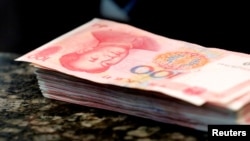Chinese commercial banks lowered interest rates on Tuesday as Beijing seeks ways to boost economic growth, which has been disappointingly slow as the country recovers from pandemic-era lockdowns and supply chain bottlenecks.
The move took place just days after the Chinese central bank announced it would cut the interest rate it charges on several different facilities it uses to supply commercial banks with cash.
The change in commercial banks’ prime rates, which are offered to borrowers with the best credit, were relatively modest. The rate on one-year loans fell to 3.55% from 3.65%, while the rate on five-year loans dropped to 4.2% from 4.3%.
Striking a balance
The change, which was the most significant adjustment to interest rates in nearly a year, was smaller than some analysts had expected. China faces continued softness in its real estate sector, high levels of indebtedness and persistently slow growth.
David Qu, an economist covering China for Bloomberg Economics, said on Bloomberg television that the small rate cut was an effort to maintain what he referred to as a “balance between stabilizing the housing market and avoiding stimulating another bubble in the housing market.”
In an analysis released last week after the Peoples Bank of China signaled that rate cuts were coming, Logan Wright and Allen Feng of the Rhodium Group wrote, “[T]he reductions in mortgage rates will not have much of an impact on property sales, but may help to reduce mortgage payment burdens for Chinese households. This is more likely designed to boost household consumption, so that households can free up and come from debt service for other purposes.”
Lower growth expected
Concerns about China’s economy have worsened in recent months, a fact that senior leaders in Beijing have begun to publicly acknowledge.
On Friday, Chinese state television reported that Premier Li Qiang told a meeting of senior Communist Party leaders that the government is exploring ways of driving growth.
“The external environment is becoming more complex and severe, and the slowdown in global trade and investment will directly affect the recovery process of our country’s economy,” Li said.
Over the weekend, Goldman Sachs Group Inc. reduced its forecast for growth in China this year to 5.4% from 6%.
The Chinese economy’s growth rate is still significantly higher than that of many developed economies, including the U.S., which the International Monetary Fund expects to grow at only 1.6% in 2023. However, China’s growth rate was as high as 7.8% 10 years ago, and has been mostly slowing since, with the exception of an anomalous 8.1% rate in 2021 as it returned from the depths of the pandemic.
More stimulus expected
After reports last month that industrial output and retail sales had both come in under expectations, some experts expected that the Chinese government would engage in a careful program of targeted economic stimulus in the near future. The trouble is that some of the most obvious levers of influence may be less potent than they have been in the past.
For instance, lower interest rates are usually seen as stimulative because they encourage borrowing to fund capital investment. However, debt levels among Chinese companies are already quite high, which will serve to dampen demand for more credit.
In recent months, Chinese officials have signaled openness to foreign investment in the country as another means of increasing economic growth.
However, this comes after a period in which Beijing’s aggressive crackdown on Chinese tech firms and high-profile visits of state security officials to the Chinese offices of Western businesses have left some companies wary.
In April, security officials entered the offices of consulting firm Bain & Company and questioned employees. That visit came a month after officials entered the offices of another U.S. firm, the Mintz Group, and detained five Chinese nationals working there.
Global challenges
The change in interest rates takes place amid a number of important discussions between China and other large economies around the world.
On Monday, U.S. Secretary of State Antony Blinken visited Beijing, where he met with Chinese Foreign Minister Qin Gang and then President Xi Jinping. Both sides characterized the discussions as productive, but on issues of significant economic concern to Beijing, no progress was announced.
These included the Biden administration’s continued application of broad tariffs on Chinese goods implemented by the administration of former President Donald Trump, and severe restrictions on China’s ability to buy cutting-edge semiconductors due to bans put in place by the Biden administration.
On Tuesday, Li traveled to Germany for meetings with senior officials there. Germany, which counts China as its second-largest trading partner after the European Union, saw its economy rocked after the Russian invasion of Ukraine exposed its over-reliance on Russia as a source of fossil fuels. The German government is in the midst of “de-risking” its economy by expanding the number of countries it relies on for key imports — a process that has China concerned about the future of its trade with Europe’s largest individual economy.








